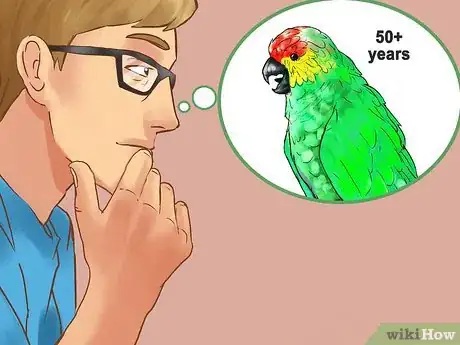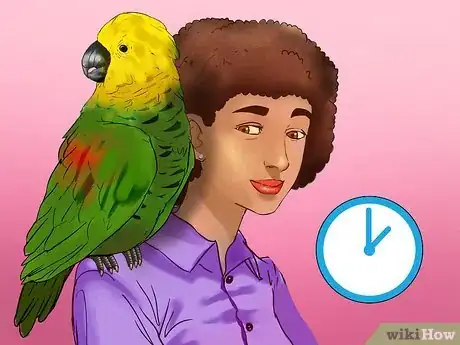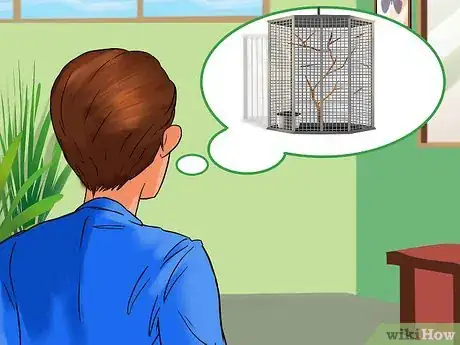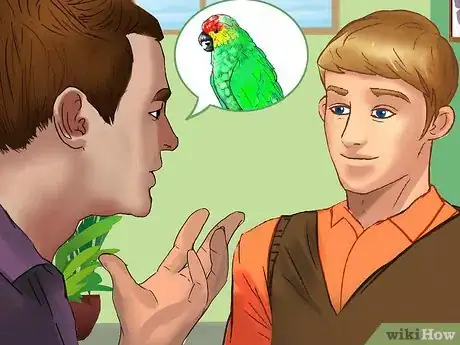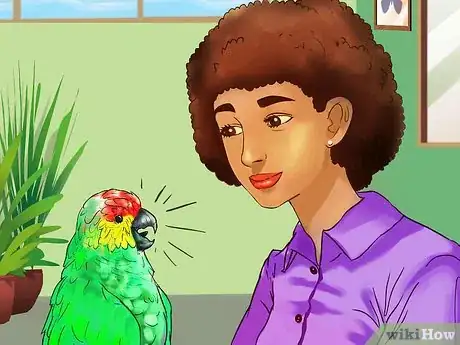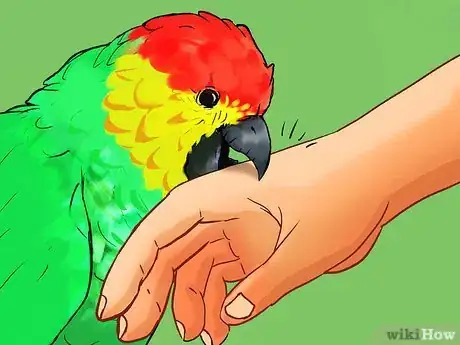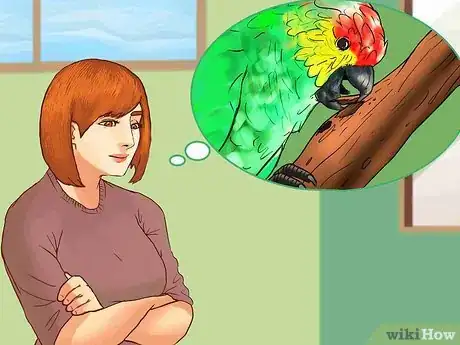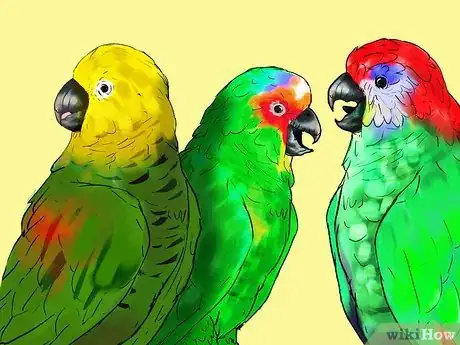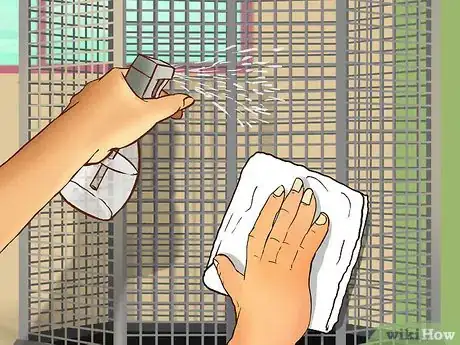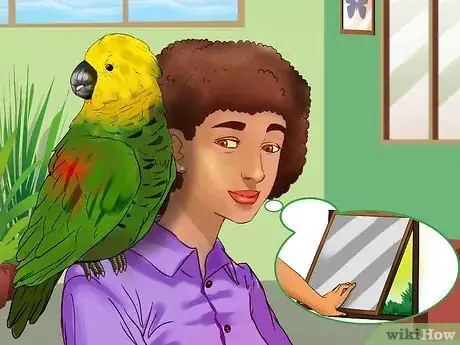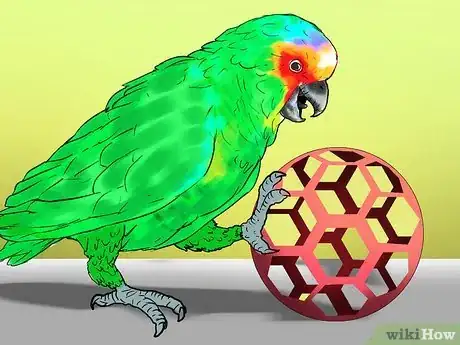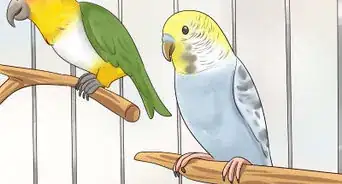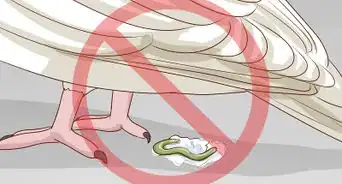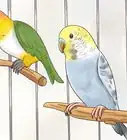This article was co-authored by Ryan Corrigan, LVT, VTS-EVN. Ryan Corrigan is a Licensed Veterinary Technician in California. She received her Bachelor of Science in Veterinary Technology from Purdue University in 2010. She is also a Member of the Academy of Equine Veterinary Nursing Technicians since 2011.
There are 17 references cited in this article, which can be found at the bottom of the page.
This article has been viewed 20,265 times.
If an Amazon is right for you, you will surely enjoy many happy years with your feathered friend. However, owning a parrot is a big responsibility and a serious time commitment. It is important to consider several factors before taking the plunge and potentially ending up with a bird that is too much work or whose personality is not a good match for you. Identify your level of aversion to messes and noise. Be sure that you’ll have adequate space to house the bird, and remember that Amazons require a great deal of care and attention.
Steps
Thinking about Your Lifestyle
-
1Be prepared for a long-term commitment. Amazon parrots can live for more than 50 years. Should you obtain such a bird, you’ll be responsible for its nutrition, veterinary care, and general well-being for the duration of its life.
- If you have plans to go on long trips, for instance, you’ll need to have someone around to care for your parrot.
- If you intend to move, you’ll need to find a way to safely transport your bird to your new home.
- You will also need to establish a relationship with a good vet who has experience treating birds (and preferably Amazon parrots in particular).
-
2Determine how much time and attention you can give. The amount of time your bird will want to spend playing and socializing will probably total about an hour each day, but a distressed bird will need even more time and attention. The time necessary to care for an Amazon parrot can be pretty substantial.[1]
- The amount of time you’ll need to spend on daily tasks like cleaning and feeding also varies depending on your speed in accomplishing them and how messy your bird is.
- Since Amazon parrots -- like people -- all have different personalities and needs, it’s impossible to quantify the exact amount of attention your Amazon parrot will require.
- Amazon parrots enjoy being the center of attention. Your parrot will clown around and do tricks to entertain you, and will want you to respond and give positive feedback.
Advertisement -
3Decide if you have the budget to care for an Amazon parrot. Annual costs can range from $170 to $950 USD. These costs include food ($100 to $250 USD), toys and miscellaneous supplies ($50 to $500 USD), water and food bowls ($8 to $30 USD), and veterinary care ($100 to $200 USD).[2]
- The precise costs associated with owning an Amazon parrot are difficult to predict, since your bird might have unique health challenges that increase the cost, and veterinary clinics charge varying rates depending on your location.
- On top of these ongoing costs, you’ll need to obtain a bird cage, which can run from $65 to $250 USD.
- Depending on the type of Amazon parrot you select, the cost of the parrot itself may range from $400 to over $1000 USD.[3]
-
4Determine if you have space to house the Amazon parrot. Amazon parrots, like all pet birds, need their own space where they feel safe and secure. If you cannot provide a separate room for a large cage with dimensions at least 32 inches wide, 23 inches deep, and 64 inches tall (81 x 58 x 163 cm), you should consider a smaller pet.[4]
- A proper cage should, additionally, have bars spaced about 3/4 to 1-3/8 inches (1.9 to 3.5 centimeters) apart.
-
5Consider the impact of an Amazon parrot on your household. Before investing in an Amazon parrot, find out if anyone in your household has avian allergies. Confirm that it will be possible to keep pets separated from your Amazon parrot, since barking dogs or pesky cats can stress Amazon parrots. Think about whether it would be possible to maintain the safety of young children with an Amazon parrot.[5]
- Some Amazons can become jealous of young children. If you get an Amazon, you might not be able to show your child affection when in the presence of the bird.
- If Amazon parrots are not properly socialized from a young age or do not get enough handling and positive attention, they may become very aggressive.
-
6Confirm that you can keep an Amazon in your house or apartment. Some landlords do not allow tenants to have pets in their apartment. A noisy creature like an Amazon parrot could also irritate your neighbors or housemates. If you’re living in an apartment building, condominium, dorm, or other shared housing situation, consult your landlord or anyone who shares your home before investing in an Amazon parrot.[6]
Dealing with Amazon Behavior
-
1Decide if you like talkative birds. The 30 species of Amazon parrots are among the most talkative birds in the world. The yellow-naped species, especially, are excellent speakers. Even the less talkative Amazons (like the lilac-crowned, red-lored, white-fronted, or blue-fronted Amazon parrots) tend to speak frequently.[7]
-
2Ask yourself if you can tolerate loud birds. Parrots often make calls and screaming sounds during the early evening and early morning hours.[8] If you can live with a noisy Amazon parrot, it will probably be a great choice for you.[9]
- If you’re not sure about how well you will handle the noise level, try spending some time in an environment with Amazon parrots. For example, if you have a friend who owns an Amazon, spend time at their place and try to get a sense of whether or not the noise bothers you.
-
3Be prepared to get bitten occasionally. If you’re anxious about potentially being bitten by a medium or large-sized parrot, it’s probably not a good idea to get one. Consider a smaller bird like a cockatiel or parakeet instead.[10]
- Amazon parrots mature into medium or large-sized birds, some of which have substantial beak strength.
- In their natural habitat, parrots use their beaks to crack shells and strip bark from trees, so there is a real danger of injury from a parrot bite.
- If you own an Amazon parrot, chances are you will get bitten at some point, even if it is by accident. Even a non-aggressive parrot may nip or nibble while playing with you. If you are willing to accept the probability of getting bitten, then an Amazon parrot may be fine for you.
-
4Think about how much of a mess you’re willing to deal with. The volume of waste produced by a particular bird corresponds to its size. Medium to large-sized birds like Amazon parrots, however, will excrete 15 to 40 times daily, with larger birds producing more waste less frequently. The bird’s cage liner, therefore, should be changed several times throughout the day.[11]
- It is impossible to quantify exactly how many times an Amazon parrot’s cage liner will need to be changed. The number will likely vary from day to day.
- Generally, however, if your bird voids frequently, you’ll need to change the liner frequently. If it voids seldom, it can be changed less frequently.
- You will also need to wash your parrot’s food and water dishes every day with hot, soapy water.
- For most pet birds, the entire cage and all accessories (including perches, toys, and nest boxes) will need to be cleaned and disinfected at least once a month. For a messy bird, you may need to do this more frequently (e.g. once a week).
-
5Ask yourself if you like mischievous birds. Amazon parrots are generally quite clever, energetic, and athletic, which can lead to acting out and mischievous behavior. For instance, they are known to destroy wooden toys and often like to “wrestle” with their owners’ hands. If you’d find this sort of mischievous behavior charming and lovable in a pet, an Amazon parrot might be right for you.[12]
-
6Identify the colors you like in birds. Amazon parrots are mostly green, with some red and/or yellow trim around the neck and head. If you dislike green birds or if you want a more colorful bird, you might consider another parrot like a macaw.[13]
Caring for Your Amazon
-
1Set up the cage. Select a cage that has approximately one inch (two centimeters) of space between the bars. Line the bottom with folded newspapers. The cage should include a number of perches set at varying heights. Additionally, your bird should have at least one bowl for food and one bowl for water.[14]
- A cage with dimensions of at least 24" x 36" x 48" (61 x 91 x 121 centimeters) should be adequate for your Amazon parrot.
- Many owners like to provide an extra food or water bowl in order to give the Amazon parrot some variety in deciding where to dine.
- Invest in heavy glass or ceramic food and water bowls, since they’re more difficult to spill. Plastic and some metal bowls, on the other hand, might leach dangerous substances into your parrot’s food or water.
-
2Feed your Amazon. Pellets should compose about 75% of your parrot’s diet. The rest should be composed of fresh fruit and vegetables, including blueberries, mangoes, sweet potatoes, strawberries, nuts, and carrots, among others.[15]
- Fruits and veggies should be washed and chopped. They can be peeled, though peeling is not necessary.
- Your Amazon parrot might also benefit from a small spoonful of seeds (including peanut and sunflower seeds).
- Although seeds are an important part of the Amazon parrot’s diet, you should not feed your parrot only seeds. The high fat and carbohydrate content in seeds can cause premature organ failure.
- Give your bird one or two almonds or walnuts as a treat each day.
- The amount of food your bird needs depends on its size and age. Older birds might eat less than younger birds. Talk to your veterinarian about how much your bird needs to eat to stay healthy.
-
3Clean your pet’s cage. Change the liner -- usually newspaper -- in your bird’s cage daily. If you see feces on the perches, clean them off with hot soap and water. Once each week, scrub the actual grates of the cage. Once each month, transfer your bird to another cage, then take its cage outside and scrub and disinfect it. Rinse the cage off with water after applying the disinfectant of your choice.
-
4Play safely with your Amazon. Before you remove your pet from its cage, close all doors and windows to prevent it from escaping. Check the room to ensure there is nothing dangerous or sharp that your bird might chew on. Always be gentle with your Amazon parrot and do not grip it too hard.
- Turn off any fans in the room, and make sure your parrot does not have access to lit candles, hot stovetops, radiators, or other heat sources and hazards.
- Amazons are very playful. Whistle a short song and your parrot might whistle back.
- Play music for your Amazon parrot and it may dance to the beat.
- If your bird doesn’t want to be picked up, it might nip or bite your hand.[16] If that happens, simply monitor it as it walks or flies around the closed room.
-
5Provide the right toys for your Amazon. Wooden blocks and balls are some of the most popular parrot toys. Toys that have chain links or strings, however, could present a choking hazard for your Amazon parrot, or wrap around their feet. Don’t give your bird such toys (or, if you do, remove the offending string first).[17]
- If your bird is eating a toy’s material -- whether it’s cloth, wood, or some other material -- take the toy away and offer another.
- Throw away any broken or worn toys so that they do not present a hazard to your parrot.
- Don’t rely on the toy’s label to tell you whether or not a toy is right or wrong for your bird.
- Check each toy’s manufacturing label to ensure that it is free of PVC.
References
- ↑ http://animal-world.com/encyclo/birds/Amazons/Amazons.htm
- ↑ http://www.petplace.com/article/birds/general/adopting-purchasing-a-bird/what-it-costs-to-own-a-bird
- ↑ http://www.parrothub.com/Amazon-parrot.html
- ↑ https://www.petfinder.com/pet-adoption/other-pet-adoption/adopting-a-bird-choosing/
- ↑ https://www.petfinder.com/pet-adoption/other-pet-adoption/adopting-a-bird-choosing/
- ↑ https://www.apartmentguide.com/blog/7-things-need-know-renting-with-pets/
- ↑ http://www.dummies.com/pets/birds/choosing-your-bird-the-best-birds-for-beginners/
- ↑ https://books.google.com/books?id=JMTUKwzPEvwC&pg=PA262
- ↑ https://www.petfinder.com/pet-adoption/other-pet-adoption/adopting-a-bird-choosing/
- ↑ https://www.petfinder.com/pet-adoption/other-pet-adoption/adopting-a-bird-choosing/
- ↑ https://petcentral.chewy.com/all-you-ever-wanted-to-know-about-bird-poop/
- ↑ https://lafeber.com/pet-birds/species/Amazon-parrot/
- ↑ http://animal-world.com/encyclo/birds/Amazons/Amazons.htm
- ↑ https://pethelpful.com/birds/How-To-Set-Up-A-Bird-Cage-For-A-Cockatiel-Parrakeet-or-Parrot
- ↑ https://vcahospitals.com/know-your-pet/Amazon-parrots-feeding
- ↑ https://lafeber.com/pet-birds/species/amazon-parrot/
- ↑ http://www.parrotparrot.com/articles/parrotsafety/playing-it-safe-with-bird-toys/
About This Article
To know if an Amazon parrot is right for you, think about whether you’re prepared to spend at least an hour a day with your bird, since Amazons need a lot of time and attention. Additionally, consider your ability to make a long-term commitment to a pet, because these birds can live for 50 or more years. You should also be ready to provide things like food, toys, and medical care, and be able to tolerate loud noises and screams throughout the day. For more information from our Veterinary co-author, like how to integrate an Amazon with any pets you already have, read on!
